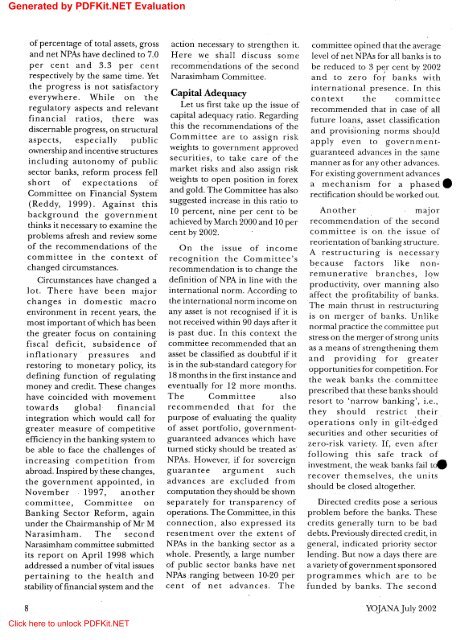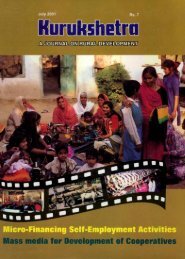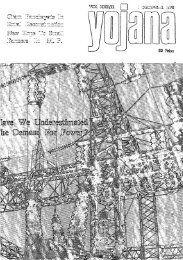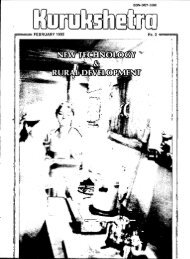Banking - Yojana
Banking - Yojana
Banking - Yojana
- TAGS
- banking
- yojana
- yojana.gov.in
Create successful ePaper yourself
Turn your PDF publications into a flip-book with our unique Google optimized e-Paper software.
Generated by PDFKit.NET Evaluation<br />
of percentage of total assets, gross<br />
and net NPAs have declined to 7.0<br />
per cent and 3.3 per cent<br />
respectively by the same time. Yet<br />
the progress is not satisfactory<br />
everywhere. While on 'the<br />
regulatory aspects and relevant<br />
financial ratios, there was<br />
discernable progress, on structural<br />
aspects, especially public<br />
ownership and incentive structures<br />
including autonomy of public<br />
sector banks, ,reform process fell<br />
short of expectations of<br />
Committee on Financial System<br />
(Reddy, 1999). Against this<br />
background the governm'ent<br />
thinks it necessary to examine the<br />
problems afresh and review some<br />
of the recommendations of the<br />
committee in the context of<br />
changed circumstances.<br />
Circumstances have changed a<br />
lot. There have been major<br />
changes in domestic macro<br />
environment in recent years, 'the<br />
most important of which has been<br />
the greater focus on containing<br />
fiscal deficit, subsidence of<br />
inflationary pressures and<br />
restoring to monetary policy, its<br />
defining function of regulating<br />
money and credit. These changes<br />
have coincided with movement<br />
towards global financial<br />
integration which would call for<br />
greater measure of competitive<br />
efficiency in the banking system to<br />
be able to face the challenges of<br />
increasing competition from<br />
abroad. Inspired by these changes,<br />
the government appointed, in<br />
November 1997, another<br />
committee, Committee on<br />
<strong>Banking</strong> Sector Reform, again<br />
under the Chairmanship of Mr M<br />
Narasimham. The second<br />
Narasimham committee submitted<br />
its report on April 1998 which<br />
addressed a number of vital issues<br />
pertaining to the health and<br />
stability of financial system and the<br />
8<br />
Click here to unlock PDFKit.NET<br />
action necessary to strengthen it.<br />
Here we shall discuss some<br />
recommendations of the second<br />
Narasimham Committee.<br />
Capital Adequacy<br />
Let us first take up the issue of<br />
capital adequacy ratio. Regarding<br />
this the recommendations of the<br />
Committee are to assign risk<br />
weights to government approved<br />
securities, to take care of the<br />
market risks and also assign risk<br />
weights to open position in forex<br />
and gold. The Committee has also<br />
suggested increase in this ratio to<br />
10 percent, nine per cent t~ be<br />
achieved by March 2000 and 10 per<br />
cent by 2002.<br />
On the issue of income<br />
recognition the Committee's<br />
recommendation is to change the<br />
definition of NPA in line with the<br />
international norm. According to<br />
the international norm income on<br />
any asset is not recognised if it is<br />
not received within 90 days after it<br />
is past due. In this context the<br />
committee recommended that an<br />
asset be classified as doubtful if it<br />
is in the sub-standard category for<br />
18 months in the first instance and<br />
eventually for 12 more months.<br />
The Committee also<br />
recommended that for the<br />
purpose of evaluating the quality<br />
of asset portfolio, governmentguaranteed<br />
advances which have<br />
turned sticky should be treated as'<br />
NPAs. However, if for sovereign<br />
guarantee argument such<br />
advances are excluded from<br />
computation they should be shown<br />
separately for transparency of<br />
operations. The Committee, in this<br />
connection, also expressed its<br />
resentment over the extent of<br />
NPAs in the banking sector as a<br />
whole. Presently, a large number<br />
of public sector banks have net<br />
NPAs ranging between 10-20 per<br />
cent of net advances. The<br />
committee opined that the average<br />
level of net NPAs for all banks is to<br />
be reduced to 3 per centby 2002<br />
and to zero fOf banks with<br />
international presence. In this<br />
context the committee<br />
recommended that in case of all<br />
future loans, asset classification<br />
and provisioning norms should<br />
apply even to governmentguaranteed<br />
advances in the same<br />
manner as for any other advances.<br />
For existing government advances<br />
a mechanism for a phased.<br />
rectification should be worked out.<br />
Another major<br />
recommendation of the second<br />
committee is on the issue of<br />
reorientation of banking structure.<br />
A restructuring is necessary<br />
because factors like nonremunerative<br />
branches, lqw<br />
productivity, over manning also<br />
affect the profitability of banks.<br />
The main thrust in restructuring<br />
is on merger of banks. Unlike<br />
normal practice the committee put<br />
stress on the merger of strong uni ts<br />
as a means of strengthening them<br />
and providing for greater<br />
opportunities for competition. For<br />
the weak banks the ,committee<br />
prescribed that these banks should<br />
resort to 'narrow banking', i.e.,<br />
they should restrict ,their<br />
operations only in gilt-edged<br />
securities and other securities of<br />
zero-risk variety. If, even after<br />
following this safe track of<br />
investment, the weak banks failt.<br />
recover themselves, the units<br />
should be closed altogether.<br />
Directed credits pose a serious<br />
problem before the banks. These<br />
credits generally turn to be bad<br />
debts. Previously directed credit, in<br />
general, indicated priority sector<br />
lending. But nowadays there are<br />
a variety of government sponsored<br />
programmes which are to be<br />
funded by banks. The second<br />
YOJANAJuly 2002






